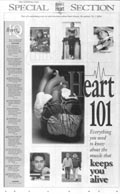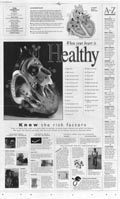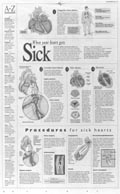Winter 2000
Health: Making a Difference in Allentown
By Pat Ford
Pew Center

They may not read every word of every story but there will be very few readers of The Morning Call who aren’t at least aware of “A Change of Heart,” the newspaper’s ambitious project to lower heart disease in the Allentown, PA, area.
The Morning Call has promised stories on the topic every single day for three years. In addition, the paper has received funding for special events, such as health fairs, to promote the project and measure its impact.
Executive Editor Ray Holton admits it’s a challenge just to sustain the project, let alone change behavior, but he’s confident of the newspaper’s role. “The guts of good journalism is getting your community involved in improving something that can be improved,” says Holton.
The newspaper has devised a number of features that will run on the same day every week. Each Monday, for instance, the paper runs a box labeled “Just for Kids” with a simple educational activity related to the heart. Each Wednesday, the food section features a healthy recipe, “Hearty Fare,” from a local chef. The recipe is analyzed by Cedar Crest College’s Nutrition and Health Department.
Managing Editor Elaine Kramer says one of the most popular weekly features is Thursday’s “Picture of Health,” a Dewars-type profile of a local resident with a healthy lifestyle. The staff checks in frequently with daily stories and, every couple of months, with big Sunday take-outs. To be sure there will always be material, the paper subscribes to Reuters medical wire.
“It was a lot more scary to think about maintaining this for three years before we got started,” says Kramer. “Now, we’re in the rhythm of it. We see there’s a lot of depth. We’ll probably retire some features and try others. We’ll need to freshen it up over time.”
One series of stories the paper launched this fall is called “Heart Monitors.” This features a group of a dozen people who volunteered to have their health and lifestyle analyzed for risk factors and then spend the next year trying to reduce their risk of heart disease through diet and exercise. The “monitors” are keeping a journal and reporters will keep track of their progress with periodic stories.
Health reporter Ann Wlazelek, who has become the project’s lead writer, thinks “heart monitors” may be the most influential feature in causing people to change high-risk behavior. “If we’ve chosen a good cross-section of people,” she says, “readers will identify with one or more of them and try the same things or at least learn what they can do to improve their diet and exercise routine, or what works to quit smoking.”
Charting Its Own Course

“Change of Heart” is another project to grow out of the success of the Baltimore Sun’s series “Reading by 9.” Sun owner, Times Mirror Co., was so impressed with the reading series, which sought to enable all third graders to read, that it encouraged all its papers (including The Morning Call) to devise journalism projects that would serve the community. The chain’s flagship paper, the Los Angeles Times, simply borrowed The Sun’s idea — title and all.
Holton says that wouldn’t have worked at The Morning Call. “‘Reading by 9’ was a wonderful idea, but it grew out of original reporting that The Sun did,” says Holton. Low reading scores were not a major concern in the Allentown area so Morning Call editors set out to find an issue that would have a broad impact.
Poring over a book of vital statistics, an assistant city editor noticed that not only is heart disease the leading cause of death in the country, the rate of death due to heart disease is higher in Pennsylvania than the country as a whole, with some of the highest death rates in The Morning Call’s circulation area.
A little bit of reporting showed that heart disease cut across all populations — young, old, urban, suburban, rich, poor — and that rates could be cut with changes in lifestyle. So editors ordered up a preliminary week-long series to launch on Valentine’s Day, as a sort of test run. A special pull-out section called “Heart 101” proved so popular that doctors and hospitals asked for reprints.
“There seemed to be a lot of material there,” says Holton. So the paper began planning its long-term coverage, including securing $275,000 from the Dorothy Rider Pool Health Care Trust to support events such as health fairs held in conjunction with the series and to evaluate how successful the effort is.
Newsroom Concerns
Reporters were not as enthusiastic about the project as management, acknowledges Kramer. “People wonder, are you going to cross the line and start catering to sponsors or manufacturing news,” says Kramer. “And they should be worried about that. I don’t have a problem with people having concerns about that. The problem would be if we couldn’t pass scrutiny.”

Kramer says the paper went a long way to settling those concerns with a story in June, which looked at how local hospitals have been getting into the lucrative heart-surgery business. The story said, in part:
Once a specialty for hospitals deemed worthy by the state of filling community need, heart-surgery programs in Pennsylvania can now be run by any medical center with enough money to start one.
That wasn’t the case before the state Department of Health stopped requiring hospitals to obtain a Certificate of Need to open new heart programs. That deregulation forced struggling community hospitals to consider heart surgery, not because the community needed it but because the hospital needed it to survive financially.
“We didn’t pull our punches,” Kramer says, of the story.
Wlazelek says, initially, she was more bothered by possible banality of the project. “When I first heard that this might be the project we picked, I sort of rolled my eyes and thought, ‘Everybody knows that; it’s old news’,” she says.
She now says she’s gained interest as she’s done more reporting for the project. “It’s affected me. I’m realizing some of the stories out there — people who’ve had heart attacks at a young age and left behind families; people who’ve had multiple heart attacks and people with family histories that put them at risk. You start to look at your own family history and your own habits.”
Wlazelek says she thinks one remaining difficulty the staff has is the time the project takes. To do heart stories on a regular basis, she says, “other stories have to wait. Things don’t get done. We haven’t added staff to do this.”
Kramer acknowledges that’s a problem but adds that concern is present any time the paper does a project.
Measuring the Impact
The Allentown Bureau of Health is “delighted” with the project, says director Barbara Spader. “Not only are they shining a light on heart disease as a major public health problem, but they’re trying to emphasize a behavior change. That’s an incredibly important community service.”
Spader serves on a roundtable of local health-care professionals that guides the project by generating ideas and reviewing the paper’s work, including checking it for technical accuracy. Spader gives the paper high marks on all counts. But she says she has cautioned Morning Call editors that it will be hard to measure the project’s effectiveness.
“It usually takes five to 10 years before you see the impact,” says Spader. “I tell them they have to be patient.”

The Morning Call has devised a number of ways to determine whether readers are actually changing their behavior in response to the series. The paper conducted a telephone survey just before the series started to test local knowledge of heart disease and its contributing factors. Holton says the paper will do a follow-up survey in June to see if awareness has increased.
Holton says the paper also has an agreement with the Allentown Blood Center to keep track of cholesterol levels in donated blood to see if they decrease as the year goes on. Also, the local Heart Association has agreed to survey patients who come in for blood pressure checks and other screening programs to see if they’ve been influenced by the newspaper project.
Kramer says she’s already seen signs that the project is succeeding. “I went to my doctor and posted on the bulletin board in the waiting room was a special section we’d produced,” says Kramer. “We know, just from casual conversation with health-care providers, this is the best patient education they’ve ever had. In a way, that’s our job. We do public education all the time.”
